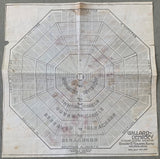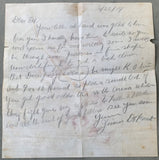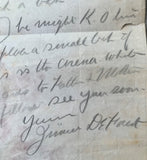DEMPSEY, JACK-JESS WILLARD SEATING CHART WITH DEMPSEY TRAINER JIMMY DEFOREST LETTER ON BACK (1919-GREAT CONTENT)
JO Sports, Inc.
Regular price $2,500.00
HISTORY: On July 4,1919 Jack Dempsey fought Jess Willard for the Heavyweight Title. In a fight that saw Willard knocked down several times and hurt badly the fight was won by Dempsey by a 3rd round TKO. Six months before the fight, former World Heavyweight Champion Tommy Burns predicted that Dempsey would defeat Willard and advised all of his friends to put their money on him. Willard's purse was $100,000 and Dempsey's was $27,500. There was a crowd of 19,500, which was less than a quarter of the arena's seating capacity. Promoter Tex Rickard said all the $60 ringside seats were sold and most of the $50 seats were sold, but the disappointment came from the sell of the cheapest tickets, which sold for $10. Provisions had been made to seat between 35,000 and 40,000 in the $10 seat section, but only about 5,000 seats were sold. Gate receipts were $452,224. The city of Toledo earned $28,751.25, and the promoters made a profit of $85,732. The temperature at ringside was 110 degrees when the fighters entered the ring. The ring was 20 feet square. The fighters wore five ounce gloves. Willard was a 6 to 5 favorite. Dempsey's manager, Jack Kearns, bet $10,000 at 10 to 1 odds that Dempsey would win by a first-round knockout. Tex Rickard not only promoted the fight, but he also served as one of the judges. "Rapid gum-chewing Ollie Pecord was the referee," Dempsey recalled for an article in the June 1982 issue of The Ring. "It was his first championship fight and he was agitated." The fight started at 4:09 in the afternoon.
When the referee signaled for the first round to start, the timekeeper, William Warren Barbour, started his stopwatch and pulled the bell cord. However, the bell didn't ring, stilled by a stray rope from the canvas. Barbour finally blew a whistle after ten seconds had elapsed, but he didn't restart his stopwatch. As a result, the round lasted just two minutes and fifty seconds. Dempsey floored Willard seven times in the first round.
The first round ended with Willard down in a neutral corner. Referee Pecord was at the count of seven when Barbour blew the whistle, but the crowd was so loud that Pecord, and many others, didn't hear it. Pecord finished the count and informed Dempsey that he was the winner. Dempsey was on his way to his dressing room when Barbour told Pecord that the round ended before he counted out Willard. Dempsey was called back into the ring and the fight continued. Willard stayed on his feet during rounds two and three, but he continued to take a beating. Willard's corner stopped the fight after the third round. Willard sat in his corner sobbing, "I have $100,000 and a farm in Kansas ... I have $100,000 and a farm in Kansas ..." William H. Rocap, sports editor of the Philadelphia newspaper the Public Ledger, wrote: "Willard must be labeled a quitter. He has disgraced the sport." There was a report after the fight that the timekeeper had written a letter to the referee stating that the one minute interval between rounds three and four had expired before Willard's corner threw in the towel. On July 14, 1919, the Army, Navy and Civilian Board of Boxing Control released an official statement on the matter, saying the bout was stopped 47 seconds after the end of round three and no such letter had been written by the timekeeper. On July 5, 1919, the Associated Press reported: "The defeated champion said today the rumor that he was severely injured and that he was taken to a hospital were gross exaggerations. The only injury he suffered was a deep cut over the eye and a badly cut mouth. He did not lose any teeth or was his jaw fractured as reported." However, most modern stories about the fight say that Willard's injuries were very severe. In 2013, The Ring's website reported: "Not only did Dempsey’s first hook break Willard’s jaw, the ensuing attack ... also reportedly produced multiple facial fractures, several broken ribs and hearing loss in one ear." On July 5, 1919, the New York Times reported: "In the first statement he has made since becoming the heavyweight champion of the world, Jack Dempsey announced today that he would draw the color line. He will pay no attention to negro challengers, but will defend his title against any white heavyweight as the occasion demands." Jack Kearns died on July 7, 1963. Shortly before his death, he approved the final draft of his memoirs, The Million Dollar Gate, and secured a deal with Sports Illustrated to publish two excerpts from the book. In one of the of excerpts, "He Didn’t Know The Gloves Were Loaded," Kearns claimed that Dempsey's hand wraps were treated with plaster of Paris. It was published in the January 13, 1964 issue of Sports Illustrated. "I've been trying for almost 45 years to get the story printed, but nobody would believe me," Willard said. "They thought it was just a sore loser complaining. I'm glad Kearns has finally admitted it. My jaw is still caved in from the beating that fellow gave me with cement on his hands." Dempsey denied that his gloves were loaded and sued Time Inc., publishers of Sports Illustrated, for $3 million. In September of 1965, they settled out of court for an undisclosed amount. Dempsey was said to be happy with the terms, which provided a statement by Sports Illustrated "wholeheartedly accepting Dempsey's denial of the charge of the late Jack Kearns."
Offered here is an original seat chart for this fight which has an incredible one page, hand written letter on the back by Dempsey trainer Jimmy DeForest. Dated 6/26/19, only 8 days before the fight a confident Deforest writes in part, "Jack is in firm shape. Now don't forget to get a bet down that Dempsey (Wins). He might K.O. him out 9 or 10 round so place a small bet if you get good odds."
FULL DESCRIPTION: This is an original seat chart for the Dempsey-Willard fight with an incredible letter from Jimmy DeForest on the back. Written in pencil and signed, "Yours Jimmie DeForest." Has been folded in both directions. Some mild spotting. Edge wear. 11" x 11 1/4." Exceedingly rare.
Size: 11" x 11 ¼"
Condition: Very Good






